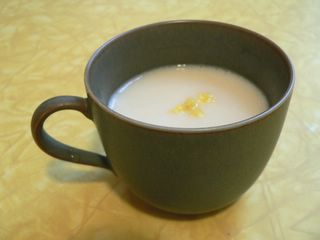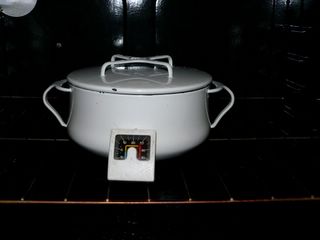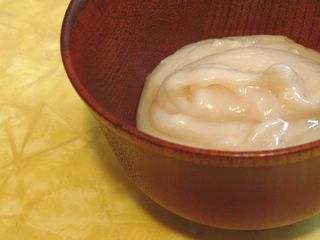homemade amazake

traditional japanese hot amazake drink with a pinch of fresh grated ginger
amazake is sneaking it's way into the american culinary consciousness. you may have seen little bottles of the stuff lurking in the refrigerated section of your local health food store, all cozied up next to the spirulina and camel dung health drinks. you know what i'm talking about, those little shakes that use amazake as a base along with nuts, fruits and various flavorings. they're thick, creamy, sweet and, of course, expensive.
for the uninitiated, amazake is nothing more than cooked grain (white or brown rice being the most common but other grains can also be used) innoculated with aspergillus oryzae in the form of koji and allowed to ferment for anywhere from 12-24 hours. the aspergillus breaks down the grain's carbohydrates into simple, unrefined sugars. the end result is a thick, sweet porridge with a very distinctive flavor. if it tastes a bit like sake to you, you are not mistaken. this is the first step in making sake (and miso and shoyu and shochu too). ama means sweet, and zake (the z is just a spelling change) stands for sake, for which we need no translation. despite this slight taste resemblance to sake, amazake is not alcoholic.

coco amazake
during the winter months in japan amazake is drunk steaming hot, diluted with water and seasoned with fresh grated ginger. i like my amazake served in this manner, but you could add other seasonings like cinnamon, nutmeg and ginger and have a sort of non-egg nog grog. or you could mix with cocoa powder and have a naturally sweetened hot chocolate drink. on the cooler end of the spectrum, you could use it to as a sweetening agent for shakes and smoothies. it is said that amazake has certain leavening powers and can be used in baking.
so, if you're into fermenting and culturing, like i am, or if you like to drink amazake but don't like to pay the big price tag, homemade might be the way to go. the process is really quite simple. first you will need the following items:

koji
koji
rice or other grain
thermometer
incubator
vessel
koji can be found in most japanese markets or online. it is nothing more than rice grains that have already been innoculated with the aspergillus. i buy it pre-prepared in the tubs pictured above. if, however, if you would like to try to make koji at home (which requires rice, the aspergillus spores plus another long fermentation), you can order the spores from gem cultures. i buy my koji premade since it saves so much time.

in the incubator
next comes the most difficult part of the process...jerry-rigging an incubator to suit you needs. for my homemade tempeh i just use my gas oven. the pilot light keeps the tempeh at about the right temperature. amazake however should be incubated at a slightly higher temperature (130 - 140f; 55-60c).
two incubator set-ups have worked for me: 1. the oven method: in my gas oven i place a cheap-y desk lamp with a 60 watt bulb, plug it in and close the door. in my oven this keeps the temperature at around 130 degrees and the amazake is done in approximately 12 hours; 2. the heating pad method: this is how my mom does it, and it takes a little longer but is less hassle. just wrap your rice and koji filled vessel in a towel and wrap inside an electric blanket or heating pad. the temperature setting to keep your blanket on will vary. on high, my little heating pad runs at about 120 degrees and the amazake is done in 22 hours.
now that we have the basics in order, let's get fermentin!
1 cup white rice, brown rice or other grain (millet, etc.), washed and drained
2 3/4 cups water
2 cups koji
1. cook rinsed rice in water at a low simmer for 30 minutes for white rice, 50 minutes for brown rice, or use a rice cooker if you have one. due to the water:grain ratio, the rice should be slightly porridge-like.
2. cool to about 140 degress farenhite (60 degrees celcius) and add koji. i use a thermometer to test the temperature but you can test with your finger - it should be just cool enough that your digit can tolerate the heat and not immediately blister but not so cool that it can linger. maybe like a really hot bath. thoroughly combine the rice and koji and place in a crock, glass jar or pyrex baking dish and cover.
3. incubate at 130 - 140 f (55 - 60 c) for 10-14 hours. if you can't get the incubator hot enough, process for an additional 5 - 10 hours until the rice is very sweet and the grains are very soft.


before incubating and after 22 hours at about 120 farenhite
4. when the rice is meltingly soft and very sweet, place in a covered saucepan and simmer for 10 minutes to stop the fermentation. be very careful not to burn it like i did my first time. after cooking, you may place amazake in a blender and puree until all rice grains are incorporated and the amazake resembles a thick pudding, or leave it as is. this is your base and you can use it thinned out to make the traditional japanese drink, dilute with water, nuts and seasonings to make a shake, or use it in baking as a honey substitute.

pureed amazake, undiluted
for more information on amazke, you can follow these links:
cybermacro has a nice little write up of the amazake making process and also sells koji online
gem cultures the great-grandaddy of all things fermentable, you can buy just about any kind of starter here, from keffir to tempeh to aspergillus to timbuktu.
dom's culture pages. he's a fermenting fool and has some nice write ups about a variety of fermentables.



12 Comments:
This is fascinating! I'm going to start looking for koji so that I can try this. Thanks!
Thank you Rae for all these explanations. Making amazake and tempeh uses to appear tedious to me. But with you, it becomes easier. I MUST find koji now, and in France, it may be the most difficult part of the recipe. Cheers !
I saw amazake the other day, and yes it was exe.... along with unpasturised miso :)
I will buy some next time and then give it a shot to make! I wonder where I can get koji here though...
susanv: yeah, making amazake is really interesting and easy. the possibilities to use it as a super unrefined sweetener are very interesting to me. let me know how it turns out!
virginie: to be honest making tempeh IS a little tedious even to me, but the results are sooo worth it...tempeh, seitan, amazake, i never use storebought anymore since you can make a huge batch and freeze for later use.
clare: being so close to asia i imagine it wouldn't be too terribly difficult to find. speaking of unpasturized miso...that is the next rotten project on my list!
Hi, Rae. I just left a comment on your homemade bagel blog (02/01), and now I'm finding more bagel inspiration (previous post)! more WOO HOO! Your pics are absolutely gorgeous!
It makes sugar? Amazing.
(I love the idea of fermenting, but I'm only a wanna-be compared to you.)
I'm not a big fan of energy drinks, so I'm giving amazake a try for my bike ride tomorrow. But storebought amazake is a little pricey, so I'll definitely try my hand at homemade. Thanks for the info!
Can I use my yogurt maker to make amazake? Grainessance sells amasake vegan nog it is so good tastes just like eggnog but they don't sell it in MI
Thanks for the info
Nice blog! I've got some amazake incubating right now!
i loved your recipe site, it really is so well made with lots of thought and very healthy and interesting articles as well! I just started a video recipe site that shows you step by step how to make stuff, www.ifoods.tv and i also started out as a blogger so it's great seeing other bloggers doing well, keep up the good work"
I have a question about the vessel for fermenting the koji and rice together. You said glass jar is o.k, but can it be a sealed mason jar? I know some ferments need air, but I'm thinking of using my adjustable heat food dehydrator as an incubator, so I would need to seal the container so the rice mixture wouldn't dry out. I really want to try this soon. Anyone with an answer, please email me at kslibi@gmail.com. Thanks for the good instructions, I can't wait to try this!
徵信社, 感情挽回, 挽回感情, 徵信, 徵信社, 徵信, 捉姦, 徵信公司, 通姦, 通姦罪, 抓姦, 抓猴, 捉猴, 捉姦, 監聽, 調查跟蹤, 反跟蹤, 外遇問題, 徵信, 捉姦, 女人徵信, 外遇問題, 女子徵信, 外遇, 徵信公司, 徵信網, 徵信, 徵信社, 外遇蒐證, 抓姦, 抓猴, 捉猴, 調查跟蹤, 反跟蹤, 感情挽回, 挽回感情, 外遇沖開, 徵信, 徵信, 徵信社, 抓姦, 徵信, 徵信社, 外遇, 外遇蒐證, 外遇, 通姦, 通姦罪, 贍養費, 徵信, 徵信社, 徵信社, 抓姦, 徵信社, 徵信社, 徵信, 徵信社, 徵信, 徵信, 徵信公司, 徵信社, 徵信, 徵信公司, 徵信社, 徵信社, 徵信社, 徵信社, 徵信社, 徵信, 徵信公司, 徵信社, 徵信, 徵信, 徵信公司, 徵信, 徵信社
Post a Comment
<< Home